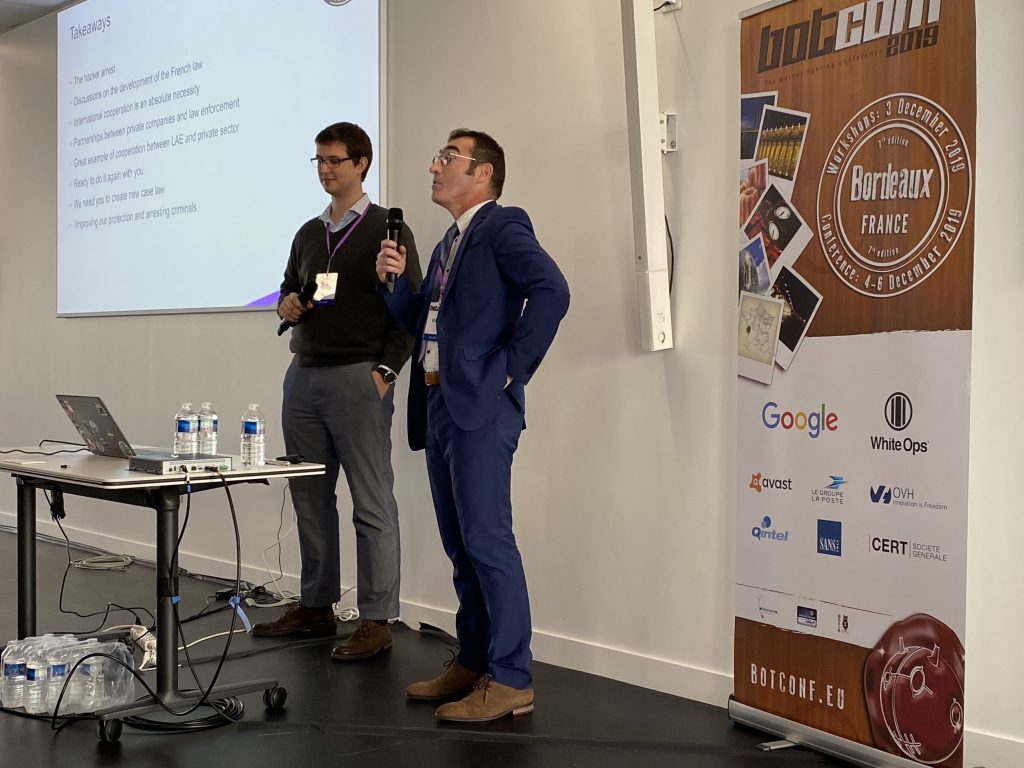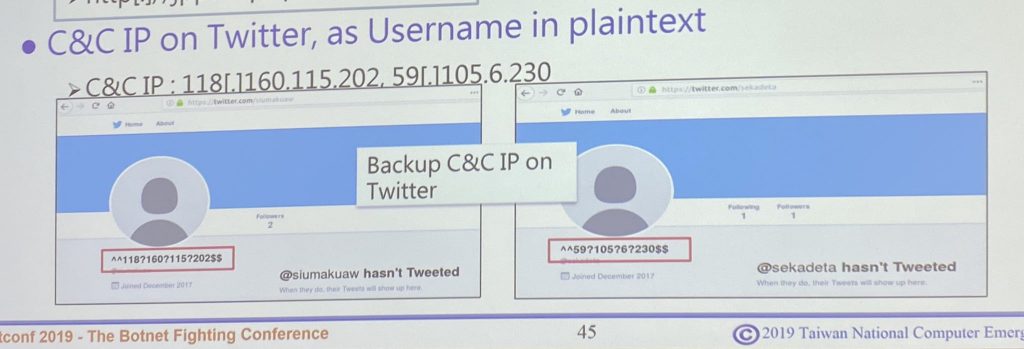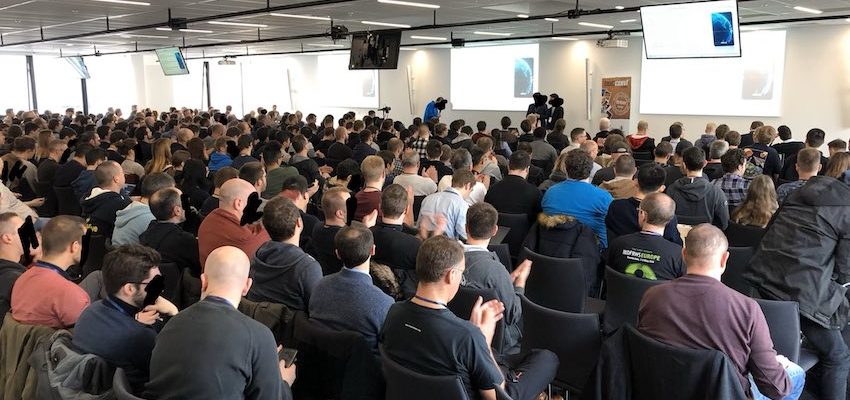Hello from Bordeaux, France where I’m attending the 7th edition (already!) of the BotConf security conference dedicated to fighting against botnets. After Nantes, Nancy, Paris, Lyon, Montpellier, Toulouse and now Bordeaux, their “tour de France†is almost completed. What will be the next location? I attended all the previous editions and many wrap-up’s are available on this blog. So, let’s start with the 2019 edition!
The conference was kicked off by Eric Freyssinet. This year, they received 73 submissions to the call for paper and 3 workshops (organized yesterday). The selection process was difficult and, according to Eric, we can expect interesting talks.
After the introduction, the first talk was ‘DeStroid – Fighting String Encryption in Android Malware†presented by Daniel Baier. He worked with Martin Lambertz on this topic.

Analyzing Android malware is not that hard because most developers use the standard API and applications can easily be decompiled. So, they have to use alternative techniques to obfuscate their interesting content. One of these is the use of encryption to hide strings. They are decrypted at run time. As you can imagine, doing this process manually is a pain. To test the DeStroid tool, they use the data set provided by Malpedia (also presented at BotConf preciously). They detected three techniques used to encrypt strings: by using a string repository, by passing strings to a decryption routine and via native libraries. Each technique was reviewed by Daniel. From a statistics point of view, 52% of the test Android samples use strings encryption and 56% of them use the “direct pass” method. The DeStroid tool was also compared to other solutions like JMD, Deobfuscator or Dex-Oracle. The tool is available here if you’re interested.
The next speaker was Marco Riccardi who presented “Golden Chickens: Uncovering A Malware-as-a-Service (MaaS) Provider and Two New Threat Actors Using It“. The talk was flagged as TLP:AMBER so I won’t disclose details about it. Just the same remark as usual which this kind of “sensitive” slides, can you trust a room full of 500 people? I like a slide (without any confidential information) that explained how to NOT do attribution:
IR > Found sample > Use technique “X†> Google for “technique X†> Found references to “China†> We are attacked by China > Case closed
The next talk focused on the gaming industry. I’m definitely not a game addict, so I’m always curious about what happens in this field. Basically, like any domain, if some profit can be made, bad guys are present! Making huge profits and targeting millions of players, it is normal to see attacks targetting big names like Counter-Strike. Ivan Korolev and Igor Zdobnov presented “Unrevealing the Architecture Behind the Counter-Strike 1.6 Botnet: Zero-Days and Trojansâ€. Do you remember that Counter-Strike was born in 1999? What’s the business behind CS 1.6? People want to play with more and more people. Servers need to be “promoted†to attract more gamers. “Boosting†is the technique to attract new players. If it can be performed with good & clean techniques, it can also be performed via malware. Ivan & Igor reviewed the different vulnerabilities found in the CS client and how it was (ab)used to build the botnet. Vulnerabilities were found in the parsing of SAV files (saved game files), BMP files. By exploiting vulnerabilities in the game, the client becomes part of a botnet. A rogue server can issue commands to a client like:
- redirecting players to another server
- tampering with configs
- change behavior of the game
In the next part of the presentation, the trojan Belonard was described.
It is active since 05/2017 and constantly use new exploits & modules. Finally, they explained the take-down process.
After the lunch breach, the keynote was presented by Gilles Schwoerer and Michal Salat. Michal is working for an AV vendor and Gilles is working for the French law enforcement services. Their keynote was called “Putting an end to Retadup“.

What is Retadup? Michal started the technical part and explained the facts around this malware: It’s a worm that affected 1.3M+ computers via malicious LNK files. It’s not only a botnet but also a platform malware being used by others to distribute more malware through it. The original version was developed in AutoIt and has persistence, extraction of the victim’s details. It also implements a lot of anti-analysis techniques. Communications with the C2 is performed via a hardcoded list of domains and simple HTTP GET request, Base64 or hex-encoded. When the malware was discovered and analyzed, the C2 was found to be located in France. That was the second part of the keynote, presented by Gilles who explained the take-down process. Their plan was to present an empty update to the bots to make them inactive. This method did not prevent the infection but was less dangerous for the end-user. US Agencies were also active in the process to redirect the DNS to the rogue C2 server deployed by the French police. This keynote was a great example of collaboration between a vendor and LE services.
The next presentation was about an “Android Botnet Analysis – Shaoye Botnet” by Min-Chun Tsai, Jen-Ho Hsiao and Ding-You Hsiao. Like the previous talk, they did a review of another malware targeting Android devices. In Chinese, “Shaoye” means “Young master”. They analyzed two versions of the malware. The first one used DNS hijacking in residential routers to redirect victims to a rogue web site. The second version used compromised websites to spread malware. In the first, a fake Facebook app was installed and, in the second version, a fake Sagawa express application (Sagawa is a major transportation company in Japan). The malware samples were completely analyzed to explain how they work.

After a welcome coffee break, a very interesting talk was presented by Piotr Bialczak and Adrian Korczak: “Tracking Botnets with Long Term Sandboxing”. The idea behind the research was about improving the analysis of bot in a sandbox for a long period of time. We know that reverse engineering malware costs a lot of time and we use sandboxes as much as possible. The biggest constraint is that time allowed to execute, usually a few minutes. Malware developers know this and make their malware wait for a long period of time (> sandbox timeout) but increase the chances that the sandbox will stop by itself. They created a “LTS” – “Long Term Sandboxing” System that is optimized to allow a bot to run for a long time but without the technical constraints. Based on Qemu and a system of external snapshots combined with other tools like an ELK stack and Moloch, they are able to reduce the CPU resource, network bandwidth, etc. They analyzed 20 families of well-known botnets and showed interest information they learned at the network level, SMTP traffic or DGA. For example, it was possible to detect unusual protocols, traffic to non-standard ports).
The next talk was “Insights and Trends in the Data-Center Security Landscape” by Daniel Goldberg and Ophir Harpaz. There were some changes but I covered this talk last week at DeepSec (see my wrap-up here).
Then, Dimitris Theodorakis and Ryan Castellucci presented “The Hunt for 3ve“. Here again another family of malware that was dissected. This one targeted online ads. Yes, ads remain a business. In a few numbers: 1.8M+ infected computers, 3B+ ad requests/day, 10K+ spoofed domains, 60K+ accounts. Eve used three techniques that were reviewed by Dimitris and Ryan:
- Boaxxe (residential proxy)
- BGP hi-jacking
- Kovter
Here again, after the technical details, they explained how the take-down process.
Finally, the first day ended with “Guildma: Timers Sent from Hell” presented by Adolf Streda, Luigino Camastra, and Jan VojteÅ¡ek. This time was analyzed malware was not only a RAT but also a spyware, password stealer and banking malware. The malware was spread through spam campaigns and was targeting mainly Brazil (at a first stage) then they targeted more countries.
That the end of day 1! Many botnets were covered, always with the same approach: hunting, find samples, analyze them, learn how they work and organize the take-down. See you tomorrow for the second wrap-up!
